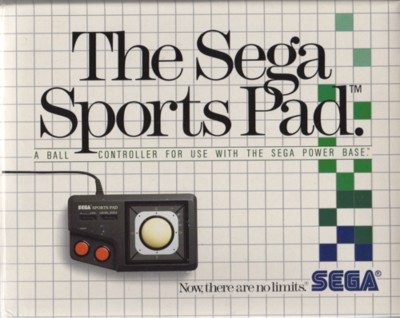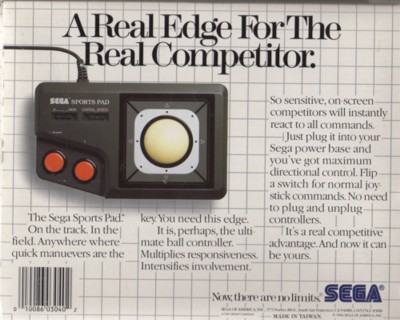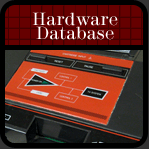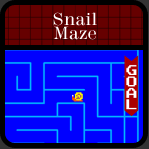 |
||
|---|---|---|
| The front of the box, concealed inside is responsiveness, maximum directional control and real competitive advantage, seriously. |
You don't really see anything like this anymore on the current video game
market. Whatever happened to crappy, poorly designed, barely functional
accessories? I mean come on, remember R.O.B. or the UForce? What
happened to that mentality and the hilarious attempts at marketing such junk?
Sigh, now you understand why I'm so obsessed with the 8-Bit era, there's just so
much crap lying about that if you need a quick upper or something to laugh at,
look no further. The Master System was not completely exempt from this hilarity
either, and for my next accessory article, I've decided to tackle one of the better
ideas (in terms of suck) to ever be puked onto the public. Here it is, baby, the
Sega Sports Pad. Well, up there I mean.
I like using box pictures to
open articles, mainly
because I
don't have to bother taking one of myself in a ridiculous position trying to be
funny, but also because they typically give the clearest view of what you're in for.
This thing is a beast. Seriously, it has to be one of the most bulky controllers I've
ever laid my hands on and is now in the running for bulkiest in history.
Measuring a sickly 19.1 centimeters across (7.5 inches),
11.4 in width (4.5 inches) and a thick, monstrous, manly 5.1 centimeters (2
inches) in girth, this controller was certainly made to please. America started
having this sick idea of "bigness" a few decades ago and it only seems to be
getting worse, though it doesn't necessarily apply here. It's interesting that Sega
decided to release this accessory only in
the states considering how hard it would be for the Master System with Nintendo
governing a totally rude monopoly. I guess they
figured they'd shoot the load. Wow, I hope you caught that one considering the
above humor. Anyway, let's get into history a bit before going
further.
 | ||
|
The
back of the pad with all four real edges captured in the picture.
|
The Sports Pad, to begin, is a trackball controller. For those of you that don't
know, a trackball controller is simply a controller that utilizes a sphere as the
main source of movement. By rotating the sphere in any direction, you can move
your character. It had its heyday in the arcades and is even still
used to some extent, but currently only on sports titles, most of which are usually
golf. The reason
and the problem is that the trackball has limited application. In theory it can
move all over the place, but in practice it really doesn't matter unless the game
you're playing is tailored to fit the usage of the ball, otherwise it's pointless.
Some classic titles were games like Centipede and Marble Madness. If you're
familiar with these, you see why it works. Centipede requires you to only move
back and forth on the bottom for the most part, so a quick roll to the left or right
works well. Marble Madness is perfect for the trackball because along with
smooth movement, you're controlling a marble, so it's almost like the trackball is
the actual marble in the game. Those are good examples, though.
As
you may well assume at this point,
the poor trackball really only found its usage in games with limited motion for
your character or whatever, or
where multi-directional movement with the ball was key to the game.
Other than
this, it's not an advantage over the traditional joystick for any other type of game.
Quite simply it could be an extreme disadvantage if not used properly. Most
arcade golf titles will use the trackball because of the ability to adjust the speed
to hit your ball based on how hard you spin it. It really works
well to make the swing aspect of the game more involved. Other than this, the
trackball is severely limited and you don't see it anymore at home other than on
expensive mice for your computer. Because of its limited application, very few
games were made utilizing it. Even in the arcade, from the early 70s up
until now, there are probably only around forty or so games that used the
trackball, that's it. There
were almost no consoles, though the ill-fated Pippin had one
on the controller. I don't think it was standard though, just part of the set-
up and more of an additional feature. Someone else thought otherwise,
however...
Sega appears to be the only company, ever, to attempt
to make the trackball a usable controller. Sega of America released the Sports
Pad in 1986, right when the SMS was starting to jump into the video game
market after the NES. At the time there were only two games made that could be
played using
it specifically, Great Ice Hockey and Sports Pad
Football, though technically you
can use it with anything. If you look at the second box picture up there, you'll
notice they mention that it can be used "on the track," almost suggested a track
and field type game may have been considered at one time. Or maybe they just
wanted to lie. I've researched everything, but there is
nothing out there to give a clue why they decided to make this. It wasn't even
released
for the Mark III in Japan until 1988, and even then the Japanese were smart
enough to realize it's uselessness and only released a single game for it, Sports Pad Soccer. The most likely issue is
that Sega attempted two things. One, it
wanted to have a flashy, unique accessory to set itself apart from Nintendo with
their ridiculous R.O.B., which itself was only made so that toy stores would
readily stock the NES since the robot was made to look like it was simply another
toy. It's likely that by throwing something large out there like this, they hoped to
catch the attention of buyers. Two, Sega attempted to appeal to a sports fanbase
in
order to sell their system. This accounts for the fact that they released two
sports titles to specifically use the trackball as it was made to be used, nothing
else was tailored to fit it. There were a number of arcade titles of different sports
that used this specifically because it worked well to the general direction of
gameplay. In addition, calling it the Sports Pad pretty much gives away
that they had something like this in mind. They also threw a few features into the
mix to try to make it more marketable.
Next Page >>





